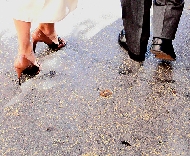Work Shoes Slowing You Down?
Posted by Hanna Baker, CO on August 29, 2013

The Starting Line:
Are your work shoes an important key to injury-free training?
Many athletes spend hundreds of dollars per year on high-end running shoes, yet still suffer from footwear-related injuries. What many of those athletes don’t realize, is that the shoes they wear when they are not running may be causing some of those injuries.
Whether a runner wears stilettos in meetings, or leather wingtips after work with friends; maintaining the integrity of those shoes is important to prevent painful injuries. Morton’s neuroma is a common condition among runners that occurs when there is increased pressure at the ball of the foot (1). Shoes that are worn-out at the ball of the foot, or have a foot shank with too much flexibility, may contribute to this pressure. Shoes worn to work should not be able to bend in half or twist through the shank. By having a more rigid or cushioned sole, the shoe absorbs more of the shock that is transmitted through the forefoot during normal gait. Neuromas can also stem from shoes being too narrow for the width of the forefoot. Wearing shoes that are wide enough in the toe box can help prevent ailments such as hallux valgus, bunions, metatarsalgia, and neuromas (1). Formal leather dress shoes - common culprits for being too tight in the forefoot - can often be ordered in wider versions or stretched at the store. Additionally, if foot orthotics are worn in running shoes, then they should also be integrated into professional shoes if possible.
It is commonly understood that high heels aren’t good for your feet (2). Even heels as low as 1.5 inches can increase forces that contribute to osteoarthritis (OA) in the knee. A study published in the Archives of Physical Medicine and Rehabilitation in 2005 explored heel heights in relation to medial compartment OA. Their results suggest that women who already have, or are predisposed to, arthritis in the knee should be advised against wearing moderately high heeled shoes (3).
Not every professional can ditch their heels or buy new shoes every three months, but reduced frequency of wear can reduce risk of injury and time away from running. Wearing well-fitted walking shoes to and from work can minimize one’s risk for common injuries seen in runners. Exchanging stilettos for platforms, with a lower heel height differential, will improve your short and long-term comfort. So, the next time you replace your running shoes, consider repairing or replacing your work shoes as well. Your body will thank you!
The Finish Line:
Maintaining the integrity of your work shoes is just as important as maintaining the integrity of your running shoes. Poorly constructed or uncomfortable work shoes can result in injuries that keep you away from your running routine.
References:
1. Goud et al. Women’s Musculoskeletal Foot Conditions Exacerbated by Shoe Wear: an Imaging Perspective. American Journal of Orthopedics. 2011 Apr;40(4):183-91. http://www.ncbi.nlm.nih.gov/pubmed/21731927
2. Allen, Shawn and Waerlop, Ivo. High Heels and Running Injuries may be Related. http://triathlon.competitor.com/2013/03/training/high-heels-and-running-injuries-may-be-related_72752. 2013 March. http://triathlon.competitor.com/2013/03/training/high-heels-and-running-injuries-may-be-related_72752
3. Kerrigan et al. Moderate-Heeled Shoes and Knee Joint Torques Relevant to the Development and Progression of Knee Osteoarthritis. Archives of Physical Medicine and Rehabilitation. 2005 May;86(5): 871–875. http://www.ncbi.nlm.nih.gov/pubmed/15895330
4. An Affordable Wardrobe. 2011 Dec. http://anaffordablewardrobe.blogspot.com/2011/12/reader-questions-old-shoes.html
Photo credit: vanz via photopin cc
*Note: This general information is not intended to be a substitute for medical treatment or advice. Always consult a professional before making changes to your health and wellness practices.
Feedback or suggestions for future topics? Let us know!
